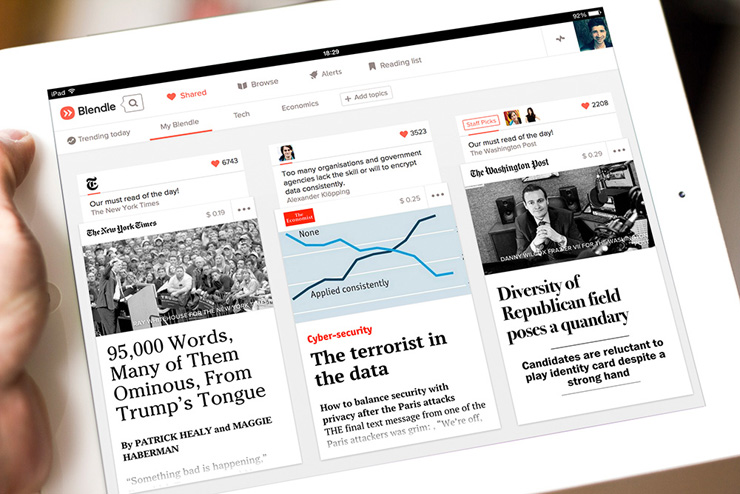Blendle, a Dutch “digital newsstand” that allows readers to pay by the article, is coming to the United States early in 2016, the company announced today.
The two-year-old company has 500,000 users in the Netherlands and Germany, and its expansion into the U.S. has been expected. Alexander Klopping, Blendle’s 28-year-old co-founder, describes the U.S. version of the service as a beta test and will not announce the roster of participating publications until the rollout begins.
“It’s all about the content,” Klopping said in a phone interview. “In the Netherlands and Germany, we tried to get all (major publishers) on board and did — that would be much harder here.” Blendle already carries content from The New York Times, Wall Street Journal and The Economist in its European versions, and the Times is an investor. So it is probably a safe guess that those three publications will be on the list.
Micro-payments for journalism “have been talked about forever and didn’t ever materialize,” Klopping said, “because the payment system didn’t work well.”
Blendle has developed an easy-to-use, secure system and other features that correct flaws in earlier commercial attempts at bringing the concept to market.
Articles typically cost between 10 and 90 cents; the publisher sets the price. A user registers and gets a $2.50 credit, then establishes a “wallet” for the account which can be replenished as it is drawn down.
In addition, Blendle comes equipped with a three-part recommendation system — an algorithm tracking the user’s interests, a way to get references from friends and editors’ selection and description of pieces of particular interest.
Another innovation is that Blendle offers your money back immediately if you don’t like the article picked. “We’ve taken away the fear that you spend 50 cents and then feel bad because the article was disappointing,” Klopping explained. In practice, fewer than one in 10 articles get refunded.
Using Blendle, users can also to scan full contents of an issue of a magazine like The Economist and pick out which articles to buy.
The articles appear without advertising. Blendle gives 70 percent of the payments to publishers and keeps the other 30. The company also boasts that more than half of users are under 35, so it has appeal to publishers trying to develop the millennial audience.
Experience to date, Klopping said, is that longer articles and background pieces do better than breaking news items. That makes the human selection component critical, Klopping said, and the United States version will initially have an editor in chief with a small team of four or five scouting for especially good pieces.
(The company posted an ad for the position, which doubtless will draw hordes of applicants).
Blendle faces a number of challenges as it moves across the ocean. In the United States, there is an abundance of material behind metered paywalls, which makes it relatively easy for users to access individual articles for free.
Nonetheless, Klopping said, “you don’t know what you may be missing that’s behind (hard) paywalls, and I expect we will be seeing them more and more.”
Hard paywalls are more the norm in Holland and Germany; plus, the language barrier keeps domestic publishers focused on their home market. The reverse is true for English-language newspapers and magazines, and the big ones have strategies in place for selling digital subscriptions internationally as well in the U.S. and U.K.
A third factor — which may have accelerated Blendle’s move into the U.S. market — is the emergence this year of Facebook’s Instant Articles and similar digital newsstand products from Google and Apple. Those are potential competitors, though Klopping has argued that they have helped break the ice for publishers presenting content on someone else’s platform.
The company is new and small with just 70 employees, half of them developers. In addition to its investment from The New York Times, Blendle has also garnered backing from German publisher Axel Springer. It launched a German version in September.
Blendle has had a few critics who think pay-by-the-article is a retro idea. But many knowledgeable media commentators, like French analyst Frederick Filloux, view it as a breakthrough.
For publishers, the appeal is not necessarily just getting paid. Filloux cites the example of a famous Dutch writer who killed himself but had given an interview five days earlier. By releasing an advance version through Blendle, the publisher also got a boost in sales once the magazine came out. That could be a match for a publisher like Condé Nast seeking to build interest for profile of a prominent celebrity such as Caitlyn Jenner.
If Blendle should prove a hit in the U.S., it could give publishers a significant boost in monetizing digital content, and Klopping is open to adding newspaper chains and other local content down the road.
The stakes are potentially high. For instance, Walter Isaacson, CEO of the Aspen Institute and biographer of Steve Jobs, has been touting micropayments as a business model game changer since his days as editor of TIME 15 years ago.
I asked Klopping what wild success in the United States would look like. “We want to be the lab to develop (adoption of paying for content),” he replied.”Whether that’s an app, a website or something else doesn’t matter. And I have no idea what it will look like in two years.”







